
|
Note ye ed's email address: stevebryant99@gmail.com. |

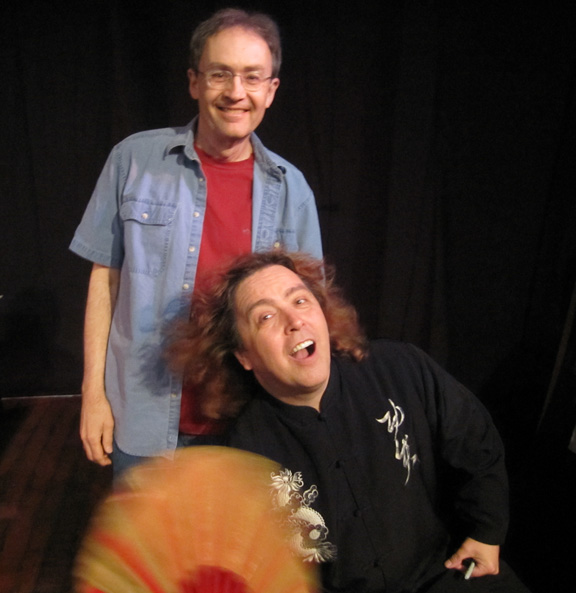
The Jeff McBride Experience.
|
June 2011 Summertime, and the livin' is easy. June began in Indiana with a weekend visit from Jeff McBride, and I squeezed in enough time to read through a surfeit of magic books, of which I shall report this month on Jamy Swiss's Devious Standards along with a couple of biographies (or four, if you count Tony Andruzzi's as three), namely Jack Kodell's Kodell/Do Something Different and Jim Magus's Unspeakable Acts. These are all fine choices for your summer reading list. Best wishes to those headed for the IBM and SAM conventions. I'll be sitting here in July phoning in each night for jury duty, but will also be "attending" EMC 2 and hope to join some of you there. Have a lovely summer. |
|
THINKING ABOUT MAGIC -- Jamy Ian Swiss takes himself seriously, and I am sure he wants us to take him seriously. But for all the serious work that he put into Devious Standards, his latest book of opinion, scholarship, and reminiscences, the main thing that I take away from it is that this book is just plain fun to read. It's hard to wipe the smile off my face. Of course, for any book that ventures into the dreaded theory of magic, one doesn't expect to agree with everything the author poses. I therefore found it surprising that I could find little to dispute in the whole book. Of greater interest is the joy one experiences when an author voices an opinion you have long shared but have never seen anyone else point out before. Of these I found plenty, and there is nothing like shared opinions to make you think an author is a genius. 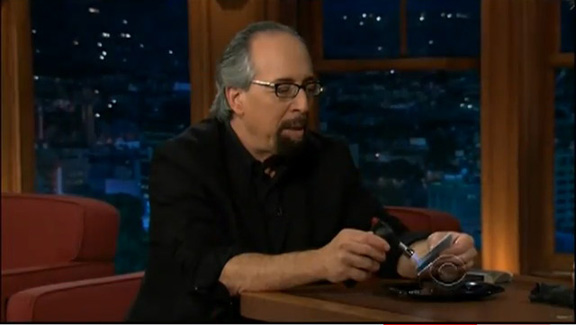 Jamy melts a block of ice over Craig Ferguson's desk. So let's take a quick run-through of some of the bits that made me so happy. In "The Method is Not the Trick," I am an instant fan of anyone who cites Robert Parrish books. Jamy nails what is wrong with so many illusionists in this essay, as well as offering a cure from Johnny Thompson. In his reminiscence of Martin Nash, the words "Out -- or in?" will give chills to any card man. In "Discovering Importance," I loved it that someone finally pointed out the futility of showing a little box empty after you've dumped a folded card out of it. "Empathy" contains a beautiful analysis of a Marlo approach to the Hofzinser ace problem. The Derek Dingle memoir, which I first read in Genii, contains a hilarious anecdote in which Jamy and Derek found themselves in the same hiding place. "A Dissertation on the Double Lift" is a grand bit of scholarship, considerably larger than the excerpt in the July Genii, in which Jamy digs deeply into the move's history and variety. I was reminded of Darwin Ortiz's attempt at encapsulating all the ace assemblies in The Annotated Erdnase and of Jamy's own attempt at summarizing the entire canon of magical literature in the January 2001 issue of Genii. The Bob Read piece is particularly notable for a magical photo tour of London to which he treated Jamy. Magicians really are nicer than people. "The JS Rules of Magic" resonated with my own thoughts on the importance of the wave of a hand, of knowing what you are talking about, and of not insulting the intelligence of an audience, and then it cracked me up with a codicil that invoked some of Martin Lewis's favorite rules. "The Last Layman" is a satire worthy of Jonathan Swift in which only one layman is left on the planet. Seriously, is this any weirder than Louis Falanga bringing his favorite video layman/spectator to the last MAGIC Live to sign autographs? Talk about the circle of art and life imitating one another. And finally, who among us of a certain age did not know Billy McComb? Jamy recounts a late-evening decision to forego a promising card session in favor of spending some quality time with Billy. His decision was spot on. The six essays first appeared in Antimony, and were new to me as I has not subscribed, and the Nash/Dingle/Read/McComb reminiscences first appeared in Genii. These pieces have been most handsomely compiled into a 230-page hardback with a ribbon to mark your favorite passage. $40 from Hermetic Press (free shipping if you also purchase Barrie Richardson's Curtain Call). (Although it has nothing to do with the book, I loved the introduction Craig Ferguson gave to Jamy for the clip shown above: "The greatest honor we can bestow on a magician on this show is to book a magician and it's not even Magic Week.") |
|
|
BUDGIES -- As I mentioned last month, Jack Kodell at 16 had the looks and moves of a movie star, and he also had more than a simple genesis of a parakeet act that would take him around the world and cement his place in magic history. I have subsequently read Jack's autobiography, Kodell/Do Something Different, and it chronicles quite a life, eerily similar to that chronicled about Marvyn Roy in Mr. Electric unplugged (substitute parakeets for light bulbs and the singing star Mary Naylor for the ice skater Carol Williams as the love interest, and you have similar success stories). Ah, but Jack graced the scene first, and his details make for a most enjoyable read. 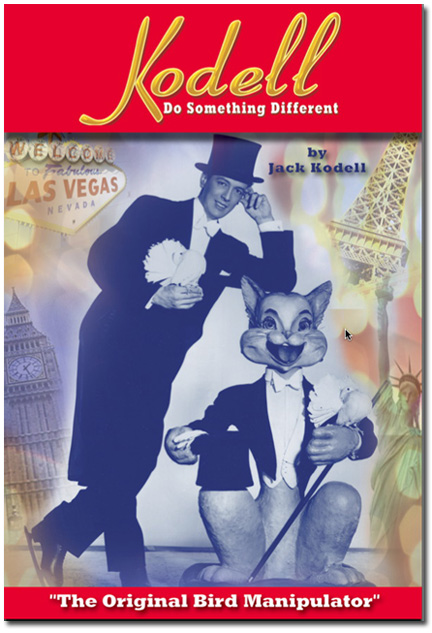 My second act featured a cat table and 37 pigeons. A few that stand out: As a boy, Jack piloted a stunt plane at 9 and won a state championship in the Soap Box Derby at 13. His parakeet act was the first to entirely feature birds in a magic act (and, secretly, to use the birds' intelligence to accomplish the magic). Jack performed a duo magic act with Don Alan, including a comedy mind reading sketch. He was the first magician to perform in a Las Vegas hotel show room, all while still a premed student at the University of Illinois. He debuted his parakeet Hindu rope trick in India, where he would join P.C. Sorcar shopping for a Fez for Johnny Platt. He married British singing star Mary Naylor even though she one day left his year's savings in a cab. News of the "love birds'" nuptials were big headlines in England. Mary negotiated for Wally Boag to be let out of his London contract (to be replaced by Jack) so that Wally could begin a stint at some new place called Disneyland. Jack was invited to perform at a private party secretly hosted by the Queen Mum and attended by the highest ranking guests in England. Jack was the first magician to perform on ice in both the U.K. and the U.S.A., the latter including Chicago's Empire Room. Through it all, Jack and Mary met and befriended a who's who of fifties show business, stars of clubs, stage, and screen throughout the world. | |
|
The book is a pleasure to read physically as well as for its fascinating anecdotes. Although a few typos crept in, the book is a treat to the eyes, beautifully laid out and designed by Jeff Pierce with photographs on virtually every one of its 330 pages. Hardback with dust cover, $59.95. Special edition (including Jack's signature, an autographed poster, a DVD with audio and video, Kodell's Three Card Trick, and seven 5 by 7 photos not seen since 1953) $99.95. From jeffpiercemagic.com. (A .pdf version will sell for $29.95.) Note that you can also see Jack Kodell's parakeet act on the "You Asked For It" DVDs produced by Bill McIlhany, available from Todd Karr, with Art Baker introducing Jack by noting all the luggage stickers Jack had accumulated from his travels. To see some of the act now, take a look at Jack Kodell's web site, where you'll find a portion of an Ed Sullivan appearance. |
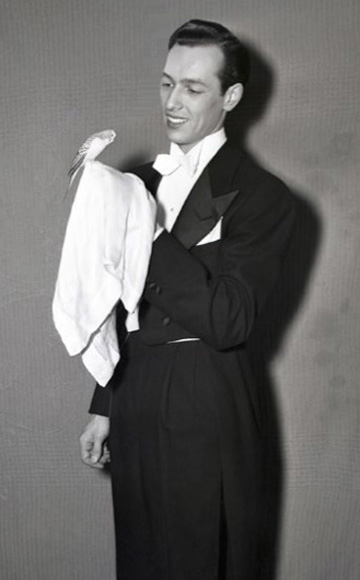 Billiard balls were so much easier. |
|
THE LIVES AND TIMES OF TIM MCGUIRE -- Or, you may know him as Tom Palmer, as Masklyn ye Mage, as Tony Andruzzi, or as all three. Unspeakable Acts, the new biography of this magical triad, by Jim Magus with Terry Nosek and Neil Tobin, traces the many lives of this extraordinary individual from his bittersweet home life through his larger-than-life magical career. Far more than a magician, a mage, and a bizarrist, Tony was also a comic, an illusion designer and builder, a clown, a Burger King (!), a writer, an editor, a publisher, a contest winner, a television producer, a bartender, a Navy man, a Warren Commission witness, a convention organizer, a son to two mothers, a father to three children, a husband to four wives, and a friend/mentor/influence to countless magicians. These would be estimable achievements for anyone, and they are all the more remarkable for a lifelong alcoholic. 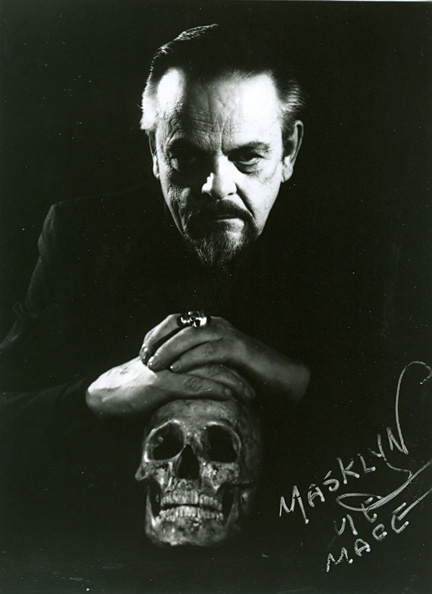 Tony Andruzzi's postcard. I learned much about Tony that I hadn't known in any detail before. Although his father abandoned the family early on, another family (the Palmers) took him and his mother in, adopting him (re-christened as Tom Palmer) and keeping his birth mom and grandmother in the picture. Not until high school, after his adoptive mom died and his birth mom moved after a remarriage, did he discover the truth. Sad yes, but Tony was surrounded by love and encouragement, especially toward his early interest in magic. I never knew that he was building illusions behind the scenes for Mark Wilson's "Magic Land of Allakazam," and my first direct contact with him was through purchasing items from the Elders (his magic shop, which at first was mail order only). There was always a touch of whimsy in his ads for Zot and Madball and the Rolon table. I eventually visited his real shop at 109 North Dearborn and cooly asked the lady behind the counter if she was Gloria (aka Vampira). "No," she said to my geeky teenage self. "I'm Bunni." By this time Gloria number one had divorced Tom over his drinking, and he had left Texas and child support payments behind. Bunni was wife number two and an asset to the comedy act that won prizes and provided employment at Playboy Clubs. (An earlier stint in Texas as a television director provided day job income for awhile, even though he gave a thumbs down to such budding talent as Pat Boone, Trini Lopez, Carol Burnett, and Elvis Presley.) I would continue to monitor Tony's career through his books and publications, and would finally get to immerse myself in the magical world he had created by attending the final two Invocationals. | |
|
I didn't attend many magic conventions until my early forties, when I finally had enough family freedom and income to do so. Until then, Bill Larsen attended for me, and I enjoyed conventions vicariously through the pages of Genii. I felt that way reading this book: Jim Magus has done a fine job of describing each effect in The Negromicon of Masklyn ye Mage, Grimoire of the Mages, Daemon's Diary, and The Legendary Scroll of Masklyn ye Mage. (Note: several fine tricks from these books appear in the October 2000 issue of Genii, and Jim Magus says that all will soon be reprinted by Collectors Workshop and Viking Magic.) Additionally, Jim has described Tony's contributions to the MOTMs leading up to the Invocationals (weren't those MOTMs supposedly top secret?), and finally Jim has chronicled just about everything that happened at the seven Invocationals. Where else could Jay Marshall do a hilarious blackout takeoff on Eugene Burger's "The Harp Weaver," could Richard Kaufman be shot for doing a card trick, could Jon Brunelle commit suicide? |
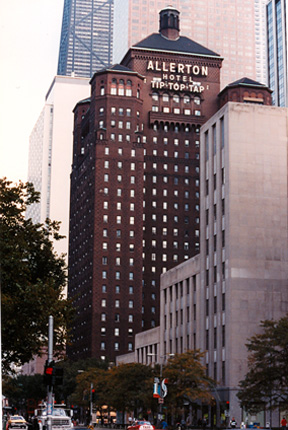 The locale of Tony's last Invocational even looked spooky. |
|
At the recent Magic Collectors Weekend, Phil Willmarth shared a story about Tony's gesture to reconcile with Gloria number one and her husband Marcom. (There was eventually a wife number three, Maria, and number four, the popular Gloria number two, who died in a tragic fire.) I'll let it remain Phil's to share, but I did enjoy the book's telling of Tony's attempted reconciliations, to the extent that they happened, with his children, and his pride that all had turned out quite well given an absentee father. I am leaving tons out. The lives of many magicians interleaved with that of Tony Andruzzi, and Jim Magus has done a fine job in the telling. This is a 535-page tome, but a fast and entertaining read. Much research had been compiled by Terry Nosek before his untimely passing, and Neil Tobin has overseen the editing. Dozens of photographs enliven the journey. For anyone new to magic, I recommend it. For anyone who knew Tony Andruzzi, you don't need me to tell you that this is a must. $75 plus $8 shipping at Stevens Magic Emporium (among others). | |
|
|
ELECTRIFYING -- Beginning on a hot June night of brilliant lightning storms, Jeff McBride descended on Indianapolis with not one but four well-attended magical events. On Saturday, June 4, he presented his full-evening ninety-minute show followed by a two-hour lecture, and Sunday he returned for a four-hour Super Secret Session. (All of this was preceded by the fourth event, which I had to miss, a Meet and Greet before the show, with champagne and hors d'oeuvres. ) Wow, what a whirlwind of activity, a visit that Jeff sandwiched between 150 shows in Tsunami-ravaged Japan and an immediate departure to Russia.  Opportunity knocks. The setting was delightful. Sponsored by Indy's Daddy Real Entertainment (Dan Dygert et al) and Taylor Martin's Indy Magic Monthly, all the events took place at the charming Theatre on the Square, itself nestled among a collection of equally charming local restaurants. The Indiana magicians turned out in droves, and even Eugene Burger trekked down from Chicago for the show. A lay couple beside me asked, "Is he anybody?" Ah, how much time do you have, folks?  Heart of the theater district. Jeff opened the show with his iconic mask routine and closed it with his playing card productions and scaling. Additional familiar silent bits, such as his water bowls and miser's dream, were also highlights. But, as Jeff explained in his lecture, you can't do a ninety-minute silent act. You have to talk. And this is where, over the two-day magicfest, Jeff surprised and delighted me. He does dead on funny impressions of people (a Renaissance street performer, a crusty gambler, a Lance Burton, a Eugene Burger), of a cooing dove, of a crying baby, of a cartoon character (Boris Badenov: "Moose and squirrel must die ..."). He excels at beatboxing. (He's so cool he can do it; I'm so uncool I had to look the term up.) Time and again I laughed at seeming ad-libs, only to learn later that they were standard lines in the show. Jeff can tell extended jokes and extended stories and get you totally wrapped up in them. All these are vocal/social skills that would have made Jeff McBride the most popular guy in my high school, and they are gold in the bank for a stage entertainer. | |
|
What else filled this fast ninety minutes? There was a fine Benson Bowl routine done as a masked Italian street performer, a gambling routine similar to one I loved in a Robert Neale book (also performed masked), a Linking Ring routine performed in a Japanese costume, a D'Lite-ful routine with dual Vortex light canes, lights on a fan, and lights from mouth, and a mentalism/prediction effect made all the more impressive because I got selected to read the prediction aloud. I have no clue. For some stage performers, indeed some of our most successful stage performers, there is just something inherently cheesy in their personas. There was absolutely nothing cheesy or fakey in Jeff McBride's persona, and no one could have treated audience volunteers with more respect. All in all, a fine show by a warm, well-defined personality. Saving the best trick for last, the entire show (plus the lecture and seminar) packs into a single piece of checked luggage. Years ago I read Jeff's notes on a commando magic act; it was a treat to finally see him do one. |
 A classy lobby. |
|
Per above, Jeff immediately followed this high-energy show with a two-hour lecture. As expected of a teacher who has run the Mystery School for twenty years and has authored "The Show Doctor" in MAGIC (soon to be a book!), it was a riveting lecture. Using the show we had just witnessed as a case study, Jeff discussed audience control, how to deal with problems, and why everything is better with confetti. Among the many tricks taught, there were how to do card manipulation without tears (including three bluff single card productions), how to zoom and bounce cards, how to float two Vortex light canes, how to produce a silk bare handed, how to create a butterfly snowstorm, how to do Kundalini Rising, and how to produce cards from your mouth, Jeff's closing effect. It was a generous spread of material, all within reach of the average serious magician, and all which would make us look great if we put in the work. 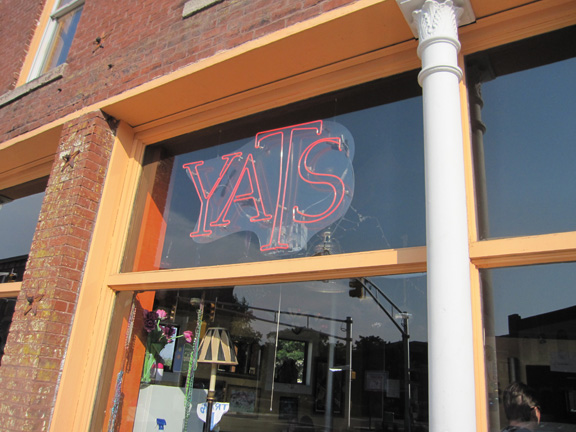 Cajun cuisine, bargain prices. OK, there was actually a fifth event if you count Jeff's joining us for Sunday lunch before the Secret Session. This at Yats, where you can find great white chicken chili. During the lunch Jeff acquiesced to a taped interview and eventually called us to order by playing music on a modified soda straw. (Again, this guy would have been a hit back in school.) Like a pied piper, he then led us next door, back to the theater, for four more hours in which he taught only one trick, a rubber band mystery. Although this extended afternoon session loosely hinged on an analysis of four stages of magical development (Trickster, Sorcerer, Oracle, and Sage), it was all specific, practical, and enlightening, with Jeff fielding numerous questions during the highly interactive session. He regarded the entire weekend as a promotion for his Mystery School master classes, and I envy those who take him up on the offer. Check it out at McBride Magic. At the very least, treat yourself and get on Jeff's mailing list. | |
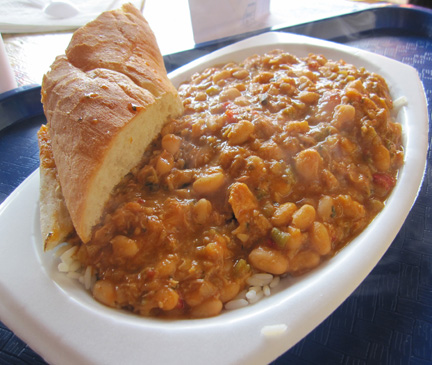 The chili with white chicken at Yats. S.W. Erdnase was W.C. Fields.
Little Egypt Magic is the erratically updated web site of Steve Bryant, spawned (the site, not Steve) by a former internet magazine known as The Little Egypt Gazette/for magicians only. Steve Bryant is an obscure magician and writer who generates this site from an iMac in Bloomington, Indiana. He frequently journeys to and performs magic in Little Egypt, the local name for extreme southern Illinois, where the towns bear such names as Cairo, Thebes, and Karnak. Past issues of this web site: Index to Past Issues Notice: Any limited use of copyrighted images or quoted text is considered fair use, usually to review whatever product or event that is under discussion. If you object to use of any material, please get in touch and it will be cheerfully removed. |
A JSB Creations product
Copyright© 2011 by Steve Bryant